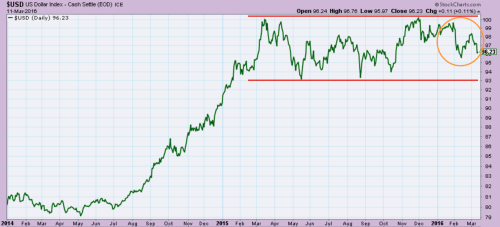After a disastrous year in 2015, industrial metals started off on the right foot in 2016. Indeed, every single base metal is up in price on the year-to-date.
But, is this price rally just another dead cat bounce or the start of new bull market? and, what factors do we need to watch for more clues?
Sharp Rallies Are Usual in Bear Markets

The PowerShares DB Base Metals (NYSE:DBB) – Price rallies during bear market (2011- today). Source: @StockCharts.com.
Since the commodity bear market started in the spring of 2011, we’ve had several price rallies in industrial metals (see the graph above), that made some people think that a new bull market was underway. It wasn’t. Sharp price rallies are not unusual in bear markets and, although base metals are showing strength, we need more evidence before confirming that this won’t be another bounce followed by further declines like we’ve seen before.
Crude Oil and Base Metals Move Simultaneously
The main driver causing metal prices to rally this quarter is the oil price recovery that’s been happening since February. Lower fuel prices have compounded the longest commodity slump in a generation as oil is also key input in the cost of producing industrial commodities.

Oil prices rally since February. Source: @StockCharts.com.
Moreover, oil is an asset closely followed by commodity investors. Falling oil prices make investors move away from commodities and, of course, industrial metals. Finally, the latest recovery in oil prices has caused oil-exporting countries such as Russia and Canada to strengthen their currencies against the US dollar. Therefore, higher oil prices contributed to a weaker dollar these past few weeks as we’ll explain soon.
As we just reported in our latest MMI, Saudi Arabia and other powerful OPEC members are reportedly discussing how to boost oil prices to $50 per barrel. Despite reports of a Russia and Saudi Arabia-approved production freeze, however, other non-OPEC nations such as Iraq still have not committed to cutting their own oil production. New production from Iran has entered the market at a much lower pace than most expected, but there is also good reason to believe Iran will ramp up production gradually as it deals with the nuances of re-entering global oil trading.
Similarly to what we see in base metals, it’s not possible to know if this oil price rally is sustainable or not. What is true is that we’ve seen oil prices bouncing in previous years, only to then see them slump so we need more evidence to believe oil prices will continue to rise. What oil prices do from now will have a huge impacts on metal prices.
Did the US Dollar Bull Market Just End?

The US dollar index moving sideways for over a year, Source: @StockCharts.com.
Base metals as commodities move in opposite directions to the dollar. In Q4 of 2015, a rising US dollar contributed to the slump in base metals. However, some factors have made the dollar weaken this quarter, helping push metal prices up.
As explained above, a recovery in oil prices contributed to a weaker dollar this quarter. Also, the euro is gaining against the dollar after the European Central Bank recently announced that it probably won’t lower interest rates more.
The dollar index (shows the performance of the dollar against a basket of currencies) has traded within main support and resistance levels (red lines in chart above) for over a year. The dollar might be topping, but it’s to early to say that. We would to see if the index breaks below support levels to call for the end of the dollar’s bull market. If that happened, we would be more inclined to call a sustainable rebound in metal prices.
China: No Signs of Rebound

Shanghai stock market composite index. Source: @StockCharts.com.
Another big factor that affects the price performance of industrial metals is China. For a sustainable rally in industrial metals we’d like to see a recovery in China, but we haven’t seen that yet. That could change but, so far, it makes the rally in base metal prices a bit suspicious. Investors’ sentiment on China hasn’t become bullish yet, at least we see that reflected in the performance of China’s stock market, which is hovering near the lows recorded in January.

Chinese February imports hit a new 6 year low in February. Source: TradingEconomics.com.
Fundamentally we don’t see signs of a turnaround, either. Indeed, if anything fundamentals are signaling more choppiness ahead. Recently, China reported a large drop in exports since the beginning of the financial crisis, with February exports down 25% year over year, confirming weak global demand which will likely be a drag on China’s economic growth in 2016. Even more worrisome for commodities might be the slump in imports. China’s imports in February fell to the lowest levels in six years, confirming weak demand in China.
Is it Now a Good Time to Buy Forward?
Well, that depends on what type of buyer you are. If you are a bottom picker then you are probably tempted to buy large quantities at these low prices. However, picking bottoms is easier said than done and it’s hardly ever a good strategy.
At MetalMiner, we always say the right moment to start buying up/hedging is at those points where there is a high probability of a price increase, and that is when the market gives real clues that the prior downtrend is over and a new uptrend is forming. Although there are glimmers of optimism in the latest metal price trends, there is still a great deal of confusion about whether the drivers of recent price increases can continue to push them higher. We’d like to see a breakdown in the US dollar, further strength in oil prices and signs of a turnaround in China to call this rally in metal prices a bull market.
by Raul de Frutos
